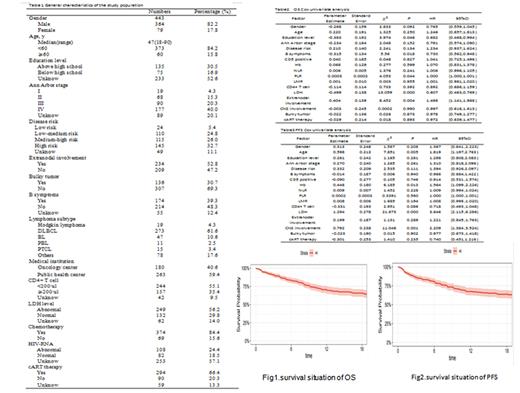Background
Over the past few decades, little has been known about HIV-related lymphoma, and there has been a lack of treatment. However, with the development of cART therapy in the 1990s, the survival of HIV-related lymphoma patients has been significantly improved, but there is still a lack of large-scale data reports on HIV-related lymphoma patients in China.Therefore, we performed a multi-center study to analyze the clinical characteristics and outcomes of HIV-related lymphoma patients in China.
Methods
We retrospectively analyzed the data of 443 patients with human immunodeficiency virus infection-related lymphoma from eleven large academic centers in China from 2008 to 2021.
Results
In the entire cohort, the median age was 47 years (range, 18-90) at lymphoma diagnosis, and 364 patients were male (82.2%).More than half of the patients came from public health treatment centers. The most common type of pathology was DLBCL (61.6%)and BL (10.6%). Most patients had elevated lactate dehydrogenase (56.2%), bulky tumor(30.7%), B symptoms(39.3%), extranodal involvement(52.8%), and advanced Ann Arbor stage (60.3%) at diagnosis. High international prognostic index (IPI) score (3-5) at diagnosis was found in 58.7% of patients. The number of patients with CD4 cell count below 200/μl was 244, accounting for 55.1% of the total. The percentage of patients who gave up chemotherapy was as high as 15.6%.
The median follow‐up of our cohort was 10.1 (0.1-160) months. The overall 1-year OS rates 70.2%. Cox univariate analysis showed that education level(HR=0.682, 95%CI 0.468-0.994; p=0.046),B symptoms(HR=0.730, 95%CI 0.562-0.948; p=0.018),PLR(ratio of the number of platelets to the number of lymphocytes)(HR=1.000, 95%CI 1.000-1.001; p=0.044),elevated LDH(HR=0.607, 95%CI 0.463-0.769; p=0.000),extranodal involvement(HR=1.498, 95%CI 1.141-1.968; p=0.004) were independent risk factor for adverse prognosis based on overall survival (OS).The overall 1-year PFS rates was 67.4%.Cox univariate analysis showed that age≥60(HR=1.819, 95%CI 1.197-2.763; p=0.005),anemia(Hb<120g/L)(HR=1.564, 95%CI 1.099-2.226; p=0.013),LDH(HR=3.646, 95%CI 2.115-6.286; p=0.000),CNS involvement(HR=2.209, 95%CI 1.384-3.524; p=0.001) were independent risk factor for adverse prognosis based on progression-free survival(PFS).
Conclusion
This is the largest retrospective study of HIV-associated lymphoma in China to date. Our results show that the proportion of men with HIV infection is much higher than that of women, which is positively correlated with the proportion of HIV infection. Patients with HIV-associated lymphoma have more risk factors at first diagnosis, including late stage, high risk layer, elevated LDH, extranodal involvement, and low CD4 cell count.
Disclosures
No relevant conflicts of interest to declare.


This feature is available to Subscribers Only
Sign In or Create an Account Close Modal